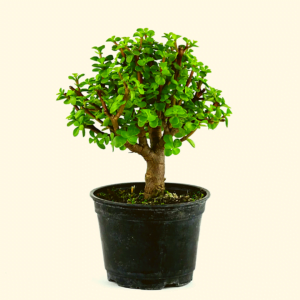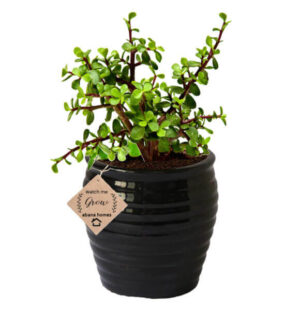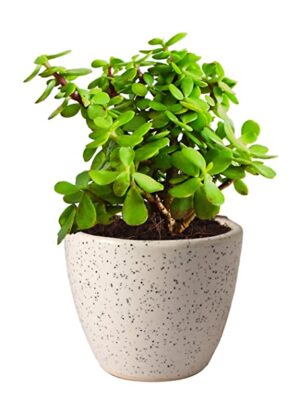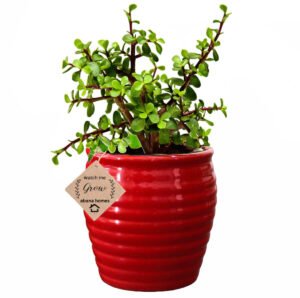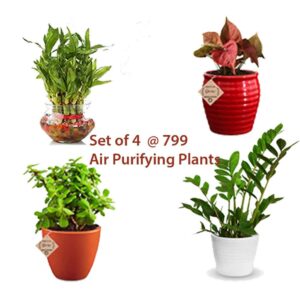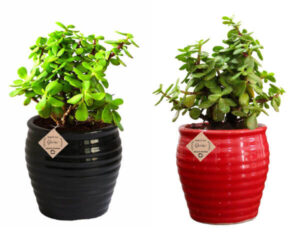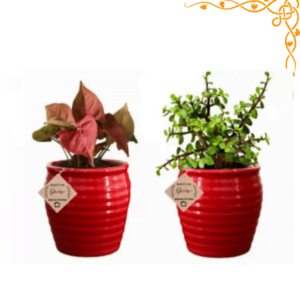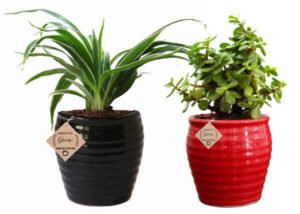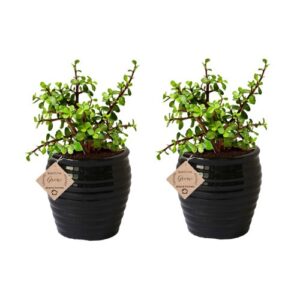Do you know that the Jade type called the Hummel’s Sunset has been garnered the royal horticultural society award for garden merit?
In this article, I will take you on a tour to the 50+ most beautiful types of jade around the world that will leave you awestruck.
Buy Jade Plants for Home Decor
If you are looking for the best jade plant in ceramic pot for your home, here are a few best seller plants that you can explore about.
About Jade Plant
| Description | The jade tree has tear-shaped, oval-shaped, or wedge-shaped green leaves and a thick woody stem. Sometimes, leaves have red blushing around the edges. |
| Height | 8 feet |
| Flowering time | Spring |
| Sunlight | Partial |
| Watering | Moderate |
| Symbolize | Prosperity and Friendship |
How Many Types of Jade Plants are There?
You will be surprised to know that there are over 1400 types of jade across the world. Some are rare and quite expensive too.
Jade plants are known for their thick branches, green color, smooth leaves with pink and white flowers.
Many of them have been cultivated over the years. Also, many cultivated varieties have been awarded accolades. For example, the Hummel’s sunset variety has been garnered the royal horticultural society award for garden merit.
Jade Plant Symbolism
Jade Plant is the representation of good fortune. They are also called Lucky plants and considered to be one of the best gifts for a friend who is moving into a new place or to a newlywed, as the jade plant is believed to be a symbol of prosperity and friendship.
The Chinese culture practices giving jade plants as a popular gift, to give or use for decoration purposes during special occasions like weddings, housewarming parties, and birthday parties.
Jade plants are also given as souvenir gifts to visitors. Although the plant is a bit pricey, the symbol of the jade plant suffices for the price and its ornamental value.
Jade Plant Identification
Are you getting confused in identifying a jade plant? Not a problem! Because below points will make you identify jade plants easily.
| Stem | Thick and woody stem Thickness of at least 4 inches Fleshy like succulent |
| Leaves | Unique tear-shaped leaves Glossy and waxy leaves Length of leaves: 3 inches |
| Flowers | Pinkish-white color flower Star-shaped(Flowering of the plant depends upon climate) |
Jade Plants Indoor or Outdoor?
Jade Plant is, both, an indoor and outdoor plant. It requires bright indirect / direct Sunlight and it grows well in any condition.
The ‘easy-going nature’ of Jade plants allows them to flourish indoors or outdoors. The secret of the healthy jade plant is good care.
Jade Plants are popular due to their ease of cultivation, adaptability, and incredible charm as a succulent. Plants like jade require little maintenance and are suitable for any home.
It will definitely be a fantastic addition to your outdoor or indoor garden.
Jade Plant Bonsai
Use code SUMMER10 to get 10% OFF
Jade Plants make wonderful bonsai trees. They are easy to bend and give shape to. Here is one of the bonsai trees that we’ve created for you and it is readily available bonsai for sale.
Types of jade plants
Several varieties of jade plants belong to the genus Crassula, and its subspecies is Crassula ovata.
There are wide types of jade with varying features and have names like Gollum, Hobbit, sunset jade, etc.
With that said, let’s check out our favorite types of jade plants.
Before we dive into the details of the Jade Plants, let’s take a look at the some of the best jade plants available for you home decor at the cheapest price.
Air Purifying Plants Combo with Jade Plants
1. Silver Dollar Jade
| Botanical name | Crassula Arborescens |
| Sunlight | Full sun to light shade |
| Watering | Occasional |
| Height | 4-5 feet |
| Flowers | White or dark pink |
| Season of interest | Spring or summer |
The plant is also known as the Blue buddha bush. As it is popular for its silver-blue leaves with burgundy edges. During the winter months, the plant develops flowers.
The flower that grows from its tips is long-lasting and grows during the autumn-winter period. You can restrict the height of the plant through containerization but the plant does not grow tall above the 60-centimeter mark.
Besides, Silver Jade is a very forgiving plant. It can tolerate drought as well as poor soil types. But you should always have a well-draining pot with a proper drainage hole. Only overwatering is the reason for the unsuccessful growth of Silver Jade. The plant is believed to bring luck.
2. Bluebird money plant
| Botanical name | Crassula Arborescens Blue Bird Variegata |
| Height | 50 cm |
| Watering | Regular |
| Sunlight | Prefers full sun |
| Season of interest | Spring |
It’s a shrub with a slow growth rate, like most jade plants in nature, but its leaves are different from those of other types. It has a mixture of aqua, cream, green, and red.
Its maximum height is about 50 centimeters, and its size can be reduced by containerization.
3. Gollum jade
| Botanical name | Crassula Ovata ‘Gollum’ |
| Sunlight | Full to partial shade |
| Watering | Moderate |
| Height | Up to 3 feet |
| Season of interest | Late fall or early Winter |
| Flowers | White or pink |
The plant got its name because of its protruding finger-like foliage. This jade type plant has tubular leaves that are red at the tips. Because of its tubular shape, it is also called “Finger Jade”, “Hobbit’s pipe jade” and “Trumpet Jade.”
The winters are filled with pink-white blooms. The plant stands out because of the curious combination of green, white, and pink that it blooms.
It is an ideal addition to the seaside gardens and flourishes during the winter autumn period. In low temperature, dryness, and low nutrition, its foliage changes color.
Also, its thick brown branches contain clusters of succulent leaves that tend to grow near the top. In addition, this is a drought-tolerant plant. Water the plant only when topsoil is completely dry.
4. Variegated Gollum Jade
| Botanical name | Crassula ovata Gollum Variegata |
| Height | 90cm |
| Flowers | White and pink |
This plant variety is slightly bigger than “Gollum Jade.” Their leaves are green with an orange tint and red tips with a spoon-like shape.
It can grow 3 feet (90cm) tall and 2 feet (60cm) wide. This jade type has small star-shaped pinkish-white flowers.
5. Jade Plant
| Botanical name | Crassula ovata |
| Height | 2.5 m |
| Flower | Pinkish-white |
| Season of interest | Winter |
Crassula ovta is popular as well as common type in jade plants. It has oval-shaped thick dark green leaves, that grow upward and span out. It also develops pink-white flowers in winter.
6. Botany Bay
| Botanical Name | Crassula ovata ‘Botany Bay’ |
| Sunlight | Full |
| Watering | Moderate |
| Height | 3 feet tall (mature plant) |
| Season of interest | Winter |
Botany Bay was introduced in 2011. The plant is compact with a bushy ovata cultivar. In a dry climate, the plant flaunts red hues. Also, the fresh green leaves of the plant have red tips.
Botany bay has coin-shaped leaves that’s why they are associated with bringing wealth. This slow-growing jade plant has a shrub-like growing nature and can be easily shaped in any form.
The most attractive feature of this species is the light jade green foliage with red margins. This red color becomes more intense in winter or in dry conditions. In an ideal condition, this type of jade can grow 1 meter tall over five years.
7. Harbor lights
| Botanical name | Crassula ovata ‘Harbor Lights’ |
| Sunlight | Full sun |
| Watering | Occasional |
| Height | 2 feet |
| Flowers | Pinkish white |
| Season of interest | Late autumn to early winter |
The plant has red tinges on the tips of green leaves. That becomes more intense in winter, making it more attractive. It is one of the best types of jade plant.
Harbor lights’ attractive color has made it a popular houseplant. It has smaller leaves compared to other crassula ovata. During the autumn and early winter months, pinkish-white flowers appear. Besides, the plant is considered ideal for seaside residential decoration.
Do you know that this plant stores water to use in times of drought?
8. Hobbit
| Botanical name | Crassula ovata ‘Hobbit’ |
| Sunlight | Full to partial shade |
| Watering | Moderate |
| Flowers | White or pink |
| Height | Up to 3 feet |
| Season of interest | Autumn |
Hobbit has fleshy green leaves with red tips and grows pink-white flowers in early winter.
This type of jade is known for its small height, it is no larger than 30 centimeters. Hobbit has emerged from the paradisia nursery in Vitoria. It has similar features related to other species such as the red tips and pinkish-white flowers in winter.
It is believed that the amount of trimming you do with the Hobbit plant connotes the amount of fortune and happiness it brings.
Another known name for this type of jade is Finger Jade, Organ Pipe Jade, or Hobbit Fingers.
9. Skinny fingers jade
| Botanical name | Crassula Argentea Gollum |
| Height | 3 feet |
| Sunlight | Full sun to partial shade |
| Watering | Regular |
| Flowers | Small pinkish-white |
| Season of interest | Late autumn to early winter |
Skinny finger jade looks similar to Gollum and Hobbit. The only difference is skinny fingers jade has much narrower, finger-like leaves. They are cylindrical in shape and have red tips. These tips bloom during autumn-winter months with pink-white flowers.
Skinny Finger Jade leaves grow up to 5 cm long and usually have red tips. The short branches and multitude of leaves give the plant a shrubby appearance.
This is not a mini jade plant but it also does not grow too large. You can expect the plant height up to 3 feet. And if you are lucky, you may see the pinkish-white star-shaped flowers in winter.
10. Hummel’s sunset
| Botanical name | Crassula ovata ‘Hummel’s Sunset’ |
| Sunlight | Full to partial shade |
| Watering | Occasional |
| Height | 1-3 feet |
| Flowers | White to pale pink |
| Season of interest | Fall to Spring |
The plant was awarded by the Royal horticultural society in 1993 for its stunning foliage color and thick bonsai styled trunk. The leaves turn from green to gold and red in the winter. For this reason, it has become a popular houseplant.
As the winter seems to goes on, its color becomes darker. Besides, Hummel’s sunset is an ideal centerpiece at the dinner table or on the shelf.
11. Little jade tree
| Botanical name | Crassula ovata ‘Little Jade Tree’ |
| Height | 12-16 inches |
| Sunlight | Full |
| Flowers | Irregular flowering |
| Watering | Moderate |
Just like its name, the bonsai plant is small and compact. It can grow up to 12-16 inches tall. The leaves are oval-shaped adorned with red edges.
Little jade was introduced into the marketplace in 2015. It was found by chance by Jan Morgan from the Glenfield wholesale Nursery Picton site. It is the most popular wedding gift or party favor. Little Jade is found in small dish gardens or inside the house.
12. Miniature jade
| Botanical name | Crassula Ovata ‘Minima’ |
| Height | Up to 2.5 feet |
| Sunlight | Full to partial shade |
| Watering | Occasional |
| Flowers | Coral pink |
| Season of interest | Early spring to late summer |
The plant develops a bushy structure in a small container and forms leaves clusters on several small branches.
During winter, it grows pinkish-white flowers. The plant grows up to 60 centimeters in height. Also, it looks great when placed on house balconies or courtyards. Mostly, it is popular for tabletop decoration and a great wedding gift.
As it is a dwarf tree, it does not grow taller than 75 cm. Compared to other types of jade this plant is not dense. Mini Jade plant gives the shrub succulent a more tree-like appearance. If you want to enhance the look of your room, miniature jade is a perfect choice.
13. Pink Jade
| Botanical name | Crassula Ovata ‘Pink Beauty’ |
| Height | Up to 1.5m |
| Sunlight | Full |
| Watering | Regular |
| Flowers | Pink |
| Season of interest | Early winter and late autumn |
This beautiful variety of jade got its name because of its cluster of star-shaped pink flowers that grow on the tips. The flowers cover the entire plant in fall and winter. Also, this jade plant has more pink colors compared to other varieties.
The foliage grows a red blush during the year under a dry climate. The early winter and late autumn develop pink flowers. Within 5 years it can grow up to 1 meter tall under ideal conditions.
The most interesting thing about Pink Jade is that it has a pink-colored stem. And this species is one of the larger types which grows up to 1.5 m tall.
14. Calico kitten
| Botanical name | Crassula Marginata ‘Variegata’ |
| Sunlight | Full |
| Watering | Regular |
| Special note | Heart-shaped leaves |
This jade type is famous for its heart-shaped leaves. The leaves have a unique combination of green, purple, and pink.
They are slow growers, but with proper care, they grow well. This plant does not grow upright so you can grow them in hanging pots.
15. Campfire
| Botanical name | Crassula capitella ‘Campfire’ |
| Sunlight | Full sun to partial shade |
| Watering | Regular |
| Height | 6 inches |
| Flowers | White or Red |
| Season of interest | Spring, summer, fall |
The plant has propeller-like foliage. And a light green and bright red hue give the plant a dramatic look. In summer, it produces white flowers.
The leaves grow from short branches and look like scarlet propellers. It has densely stacked, triangular leaves in branches up to 6 inches long.
During winter, the tips of the leaves have shades of crimson.
Though the plant is eye-catching because of its red and green shade, it is not an ideal plant to grow inside.
16. Crassula Moonglow
| Botanical name | Crassula mesembryanthemoides |
| Height | 12 inches |
| Sunlight | Full |
| Watering | Occasional |
| Flowers | Red or white |
It has long and narrow grey-green leaves with small white hair that gives the plant a silver shine and makes it look like it’s covered in frost.
You can feel the softness of the leaves when you touch them. The leaves grow upright and forms a dense cluster of small columns.
Moonglow is the hybrid of crassula falcata and crassula deceptor. Since it is a hybrid variety you can grow it even in the worst conditions.
When this plant becomes fully matured, it develops beautiful white or red-colored flowers from the middle of the rosettes.
17. Fairy crassula
| Botanical name | Crassula Multicava |
| Sunlight | Full |
| Watering | Moderate |
| Flower | Pink and white |
| Season of interest | Winter |
The plant looks like a sedum plant with spoon-shaped green leaves that have red edges. When it is planted in groups, it creates an outstanding uniform look.
Compared to other succulents, it grows pretty fast. Also, it forms a beautiful mat. The green-colored leaves grow in opposite directions. In winter, it blooms pink to white star-shaped flowers.
18. Red Flames
| Botanical name | Crassula Capitella Thunb |
| Sunlight | Full sun to partial shade |
| Watering | Moderate |
| Flowers | Not a flowering plant |
The plant has distinct-looking foliage that looks like a pink-tinged rosette. When grown in shade, the leaves take a bright apple-green color.
19. Baby’s Necklace
| Botanical name | Crassula Rupestris |
| Sunlight | Full |
| Watering | Moderate |
| Special note | Unique color of leaves |
It has small round-shaped gray-green reddish leaves that look like a beaded necklace. It is one of the prettiest crassula hybrids.
Another reason to admire this jade is the unusually colored leaves. In contrast to greenish-yellow or bluish-yellow leaves, maroon edging can be seen on the tips of the leaves.
The species can withstand mild frost, but it is best to keep them indoors during the winter.
20. Propeller plant
| Botanical name | Crassula falcata |
| Sunlight | Full to partial shade |
| Watering | Regular |
| Height | 2-3 feet |
| Flower | Red |
| Season of interest | Summer and fall |
It has got the name because of its flat propeller-like succulent leaves. In proper growing condition, the plant produces gorgeous red blooms. The plant rarely flowers, but when it does, it produces dense clusters of red flowers in the center of the propellers.
This succulent produces scarlet red and tiny flowers in the summer months. You can use them to enhance your indoor garden. It is drought tolerant plant.
21. Gandalf Jade
| Botanical name | Crassula ‘Gandalf’ |
| Sunlight | Full |
| Watering | Regular |
| Flowers | Not a flowering plant |
‘Gandalf’ is a new, compact hybrid Jade Plant that features bright green, tubular succulent leaves with spoon-shaped suction cups.
The plant variety is a hybrid of horn-tree and minor. It has green tube-like leaves with purple-red edges. It is said to bring good luck to its owner.
22. Miniature Pine tree
| Botanical name | Crassula Tetragona |
| Sunlight | Full |
| Watering | Moderate |
| Flowers | White |
Tetragona gets its name from the arrangement of leaves along the stem. Many people grow Miniature Pine trees as ornamental plants. It can grow approximately 3 feet tall.
This is one of the low-maintenance succulent plants. It has needle-like and awl-shaped leaves with a rich apple-green hue on trunk-like stems.
The plant leaves vary from dark green to green during summer. Also, the plant produces beautiful, small, white flowers.
The plant prefers bright sun and can survive mild frost. Also, you need not worry about pests for this plant except for mealy bugs.
23. Variegated jade plant
| Botanical name | Crassula ovata ‘Variegata’ |
| Sunlight | Full |
| Watering | Moderate |
| Flower | Pink-white |
It is a Slow-growing, elegantly branched shrub with attractive green foliage striped in ivory and pale yellow. Also, an excellent choice for containers and rock gardens.
Variegated Jade Plants produce showy clusters of white, star-shaped flowers with pink overtones from late winter to early spring.
Leaves are attractively green with white stripes and buttery yellow tinges. The rounded leaves are highly ornamental and remain green throughout the winter.
24. Crosby’s Red
| Botanical name | Crassula Ovata ‘Crosby’s Red’ |
| Sunlight | Full to partial shade |
| Watering | Regular |
| Height | Up to 3 feet |
| Flowers | White |
| Season of interest | Late fall to early winter |
Crosby’s Red is somewhat similar to regular jade. But it is more compact and smaller. In good sun exposure, it produces a magnificent hue of red.
Crosby’s every branch is covered in light green and red tear-shaped leaves, giving the plant a warm cozy look. This dwarf jade grows 2.5cm long leaves. An interesting identifying feature of this jade plant is that newly-grown leaves are completely red.
The plant will forgive delayed watering but not soil that is waterlogged. Standing in water for a long time makes this plant prone to fungal infection or root rot.
25. Ripple Jade Plant
| Botanical name | Crassula Ovata ‘Ripple Jade’ |
| Sunlight | Full to partial shade |
| Watering | Moderate |
| Height | 4 feet |
| Flowers | White |
| Season of interest | Spring |
It is also called the “Curly jade plant.” The plant is named “ Ripple Jade” because of its twisted appearance of bluish-green-gray leaves. Each leaf has a purplish or dark brown edge. It can grow up to 90 cm long.
It was first observed in 1974 and introduced into market place soon after that. It is mostly preferred for decorative purposes. Also, it has bonsai characteristics and its waxy leaves make it stand out from other plants. In addition, it has foliage all year round.
Ripple Jade is a drought-tolerant plant but water the tree when leaves start to get wrinkle. Also, protect the plant from hard frost.
26. Pork Bush
| Botanical name | Portulacaria Afra |
| Sunlight | Full sun to partial shade |
| Watering | Occasional |
| Height | 12 feet |
| Flowers | White, pink or purple |
| Season of interest | Late spring or early summer |
| Special note | It rarely flowers during cultivation |
Pork bush plants do not belong to the crassula genus, though they look similar to the original jade plants. It’s a natural bonsai that needs to be trained to look like one. Therefore they are called Dwarf jade.
The plant has woody red stems and small, round, and glossy green leaves.
Pork bush is also known as the Chinese jade plant. It has decorative and structural succulent features, which makes it an ideal houseplant.
It can grow up to 2 meters in height and with proper pruning, it can be controlled and shaped. Pork bush can withstand long droughts and heatwaves.
27. Yellow Rainbow bush
| Botanical name | Portulacaria afra ‘Aurea’ |
| Sunlight | Full sun to light shade |
| Watering | Regular |
| Height | 70cm-1m |
| Flowers | Whitish pink |
This is a slow-growing succulent plant that has beautiful red-brown stems and round pale yellow to light green leaves.
Yellow Rainbow bush is also known as Yellow Elephant’s food. The plant changes its color throughout its growth. It changes shades as per the time of the year and the amount of water it gets as well as the fertilizer that is used to grow it.
It grows well in both full sunlight and light shade. But it rarely displays the whitish-pink flowers that is one of the characteristics of jade plants. In height, it can grow 1 meter tall.
28. Trailing Elephant bush
| Botanical name | Portulacaria afra ‘Cascade’ |
| Sunlight | Full sun |
| Watering | Moderate |
| Height | 15cm-1m |
| Flowers | Not a flowering plant |
This plant is attractive as it has maroon stems covered with rounded, fleshy leaves. It looks beautiful over walls and achieves incredible lengths.
The cascade of the plant is known as Prostrata, the Low Elephant Bushor, Trailing Elephant Bush. it is not grown as a flowering plant. This type of jade can grow 1 meter in size. Usually, it is used for cascading over dry retaining walls.
29. Large Elephant leaf bush
| Botanical name | Portulacaria afra macrophylla |
| Sunlight | Full sun to partial shade |
| Watering | Occasional |
| Height | 8-12 feet |
| Flower | Lavender |
| Season of interest | Summer |
This plant grows 8-12 feet tall with reddish-brown stems and 1 inch long leaves that are emerald green. It is similar to Portulacaria afra but with leaves twice the size and more widely spaced.
The leaves of this variety are rounded, fleshy green with a red edge and dark, red stems. It can be grown as a houseplant. Moreover, this beautiful succulent can be pruned to control its size.
30. Rainbow bush
| Botanical name | Portulacaria afra ‘Variegata’ |
| Sunlight | Full sun |
| Watering | Regular |
| Height | 70cm-1m |
| Flowers | Not a flowering plant |
It is a sprawling, slow-growing succulent shrub with attractive reddish-brown stems and creamy-green, three-quarter-inch leaves.
It also has a tinge of magenta on the leaf edge, which grows all year round. It is not a flowering plant and can grow 1 meter tall.
This is an easy-to-grow succulent that is perfect for bonsai, hanging baskets, or even as a hedge in frost-free climates.
31. Money Plant
| Botanical name | Crassula Ovata |
| Sunlight | Part Shade |
| Height | 3-6 feet |
| Flowers | White to pink |
| Season of interest | Late winter and early spring |
| Watering | Moderate |
Money plant is known as the friendship plant or the lucky jade. It is one of the original varieties of jade plants that was discovered first and also the most popular variety today.
It is the hardy and fastest-growing of all the ovata cultivars. During winter, pinkish-white flowers appear on the tip of the jade plant. In some cases, it can grow 2 meters tall.
Most people consider money plants as ideal for planting near coastal areas. It is also used to display in gardens or dividers when pruned properly. But the best place for a money plant is a bright location away from direct sunlight.
The leaves are so numerous that they make the plant look like a lush indoor shrub. These succulent leaves grow 3-9 cm long. Feng Shui practices say that this “good luck” plant should be kept in the “money area” of a home or office.
Moreover, it is a low-maintenance plant you can grow indoors or outdoor. Make sure not to plant the tree in poorly draining soil because it won’t tolerate that. Also, it can withstand low humidity and drought.
32. Green Penny Jade
| Botanical name | Portulacaria Afra Large Leaf |
| Sunlight | Full |
| Watering | Regular |
| Height | 2m |
| Flowers | Not a flowering plant |
This jade type is having round, fleshy leaves that grow on dark red stems. But it does not grow any flower. The plant can grow about 2 meters in length, it can be controlled by pruning.
It is a popular houseplant used to decorate balconies. It can also be shaped into hedges and fences as well as screens.
33. Lemon and Lime
| Botanical name | Crassula ovata ‘Lemon and Lime’ |
| Sunlight | Full to partial shade |
| Watering | Occasional |
| Height | 1-4 feet |
| Flowers | White |
| Season of interest | Late winter to early spring |
Lemon and lime have elongated oval-shaped leaves that have light lime and yellow color stripes. When grown in sun, these leaves grow 5 cm long and develop light reddish edges.
The ‘Lemon & Lime’ jade bush can grow up to 4 feet tall and can be pruned to maintain its form as a shrub.
It is an ideal outdoor plant. Also, the plant has good heat tolerance.
34. Silver Springtime
| Botanical name | Crassula Silver Springtime |
| Sunlight | Full |
| Watering | Moderate |
| Flowers | Pink |
| Season of interest | Winter |
This succulent plant has a thin stem that is packed with clusters of pumps slivery-green colored leaves. Also, it blooms with beautiful pink flowers.
As a result, of its dwarf-like appearance, the ‘Silver Springtime’ sits well on office desks, tables, or other surfaces away from sunlight.
The plant is considered a cross between the perfoliata and rupestris variety. In winter protect this plant from the frost.
The interesting fact about this jade type is that it likes to remain pot-bound, which means it does not require often repotting.
35. Jade Necklace
| Botanical name | Crassula Marnieriana |
| Sunlight | Full to partial shade |
| Watering | Regular |
| Height | 15cm |
| Flowers | Pink |
| Season of interest | Spring, early summer, winter |
The Jade Necklace is a hybrid of Crassula perfoliata and Crassula Rupestris. It is quite similar to the “silver springtime.” This plant has thin leaves covered in triangular chubby succulent leaves.
It is an upright plant with erect leaves forming columns. The leaves are green but look frosted with white papillae.
This type of jade is somewhat smaller compared to other jade plants and gives this succulent a necklace-like appearance.
In winter, the plant develops beautiful clusters of white starry flowers emerging from the end of the stems. During blooming season, small, pinkish flowers appear. You can enjoy this plant outdoor or indoors but just avoid extreme frost and hot mid-afternoon sun.
36. Hottentotta Jade Plant
| Botanical name | Crassula Sericea ‘Hottentotta |
| Sunlight | Full sun |
| Watering | Moderate |
| Height | 15cm |
| Flowers | white |
Another type of jade plant is a dwarf variety of genus crassula, Hottentotta. This is a small succulent plant that looks more like lithops succulents than a jade plant.
It has fuzzy leaves surrounded to small thin stems. Also, do not expect this dwarf variety to grow higher than 15 cm.
When the plant flowers, it produces clusters of tiny flowers on an elongated flowerhead.
37. Blush Plakkie
| Botanical name | Crassula Cultrata |
| Sunlight | Full sun |
| Watering | Moderate |
| Height | 80cm |
| Flower | yellowish-green |
It is also named the “sharp-leaved Crassula.” Blush Plakkie is identified by its reddish stems and light green elongated tear-shaped leaves. It also has reddish-brown blushing on the edges of many leaves.
This type of jade grows about 80 cm tall. It looks more like a shrub rather than a tree. It develops tiny yellowish flowers in the form of clusters from the ends of the stems.
38. Wooly Crassula
| Botanical name | Crassula Tomentosa |
| Sunlight | Full sun, Light shade |
| Watering | Regular |
| Height | 60cm |
| Flower | Yellowish flower |
| Season of interest | Early to mid-summer |
It is one of the interesting types of jade plant, as its leaves grow in a rosette shape. The leaves are mostly green in color but there can be some red-colored leaves also.
The reason it is called “wooly jade” is because of its fine hairs that cover the leaves. In the flowering season, this houseplant can reach a height of 60 cm.
39. Red Jade Plant
| Botanical name | Crassula Coccinea |
| Height | 40cm |
| Flowers | Red |
| Season of interest | Summer |
If you want different flower color in jade then Red Jade is the best choice. Because like other jade species it does not produce pinkish-white flowers. Besides, it produces deep red flowers.
It has triangulate-shaped leaves that form cone-like stems. And this jade shrub grows 40cm tall. Also, Red jade differs in flowering time, it blooms in summer rather than in winter.
40. Pixie
| Botanical name | Crassula ovata ‘Pixie’ |
| Sunlight | Moderate to bright light |
| Watering | Regular |
| Height | 60cm |
| Flowers | White and pink |
| Season of interest | Autumn and winter |
Pixie was introduced in 2014, this compact jade has green leaves that take a red hue when the plant is stressed. It also grows tiny pinkish-white flowers in colder months. This is the best type of jade as a houseplant.
The height of the plant is determined by the size of the pot used in this type of jade plant. Also, it requires bright lights and thorough watering.
41. Barklyi
| Botanical name | Crassula Barklyi |
| Sunlight | Strong sunlight |
| Watering | Moderate |
| Height | 90 millimeters tall |
| Flowers | White |
Barklyi type of jade is known for its strange appearance. The plant resembles a rattlesnake tail. It is mostly grown in the area of the Northern Cape of South Africa.
You may find this plant in rocky or graveled areas. This succulent plant has an erect stem that looks like a rattlesnake tail.
The growth of the plant is slow and it may reach up to the height of 90-millimeters tall. For the growth of the plant, it needs strong sunlight. You can either plant the Barklyi in the garden or place it near the south-facing window.
For Barklyi, use a rocky blend potting mix for growing indoors. Also, never overwater it, as it can cause root rot.
42. Brevifolia
| Botanical name | Crassula Brevifolia |
| Sunlight | Full sun |
| Height | 1-2 feet |
| Watering | Regular |
| Flowers | Pinkish |
| Season of interest | Early fall |
Brevifolia is a small succulent plant having short, fleshy leaves with rounded edges. Under full sun, this edge turns reddish. It grows best under bright light.
The plant produces pinkish flowers in early fall. But if the plant is not placed under direct sun, it will not produce flowers. It prefers neutral to slightly acidic soil but does not like extreme pH levels.
43. Tom Thumb
| Botanical name | Crassula Commutata |
| Sunlight | Full |
| Watering | Occasional |
| Flowers | Not a flowering plant |
The plant has triangular leaves that retain moisture and help the plant to withstand drought.
These leaves are the most attractive part of the plant because of their exceptional reddish edge and green colors.
The good thing about these plants is that they don’t require too much attention, they are considered low maintenance plants.
44. Deceptor
| Botanical name | Crassula Deceptor |
| Height | 15cm |
| Watering | Moderate |
| Sunlight | Full |
| Season of interest | Winter |
Deceptor is one of the beautiful types of jade because of its beautiful leaf color and small size.
Their clumps can reach up to 15 cm tall. It blooms the flowers in winter.
The leaves are tubular and have triangular pointy shapes. Also, this type of jade does not require much attention for their growth.
45. Mucosa
| Botanical name | Crassula Mucosa |
| Height | 12 inches |
| Sunlight | Full |
| Watering | Moderate |
The plant has got its name because of its moss-like structure. It is easy to care for and always looks clean.
Also, this plant can be a great addition to indoor gardens. The chain of Mucosa grows 12 inches tall and 8 inches wide.
It has light green color leaves which rely more on sunlight for its color. Under the right conditions, this plant grows ideally.
46. Pellucida
| Botanical name | Crassula Pellucida Variegata |
| Sunlight | Full |
| Watering | Regular |
| Flower | Pink and white |
| Season of interest | Spring |
Pellucida has yellow or green fleshy leaves with a pink to red color around the edges. In spring, the plant produces star-shaped, whitish-pink flowers.
This plant looks pretty if maintained well. Also, this plant grows well in a lot of light. It needs a minimum of 5-6 hours of direct sunlight. A sunny indoor location is an ideal place for the plant.
47. String of Buttons
| Botanical name | Crassula Perforata |
| Sunlight | Full sun to light shade |
| Watering | Regular |
| Height | 1-2 feet |
| Flowers | Pale yellow |
| Season of interest | Spring |
This jade type is unique because it has leaves stacked on top of each other. Locally the plant is also known as Necklace Vine.
The leaves of the plant look like pasta and necklaces with grey and green colors. Also, there are white or pink dots across the margin. These leaves grow in a tight and spiral formation on the stem. It produces pale yellow flowers.
The strings of the button plant prefer bright sunlight to grow. And in more sunlight, the pink color becomes more intense.
48. Tiger Jade
| Botanical name | Crassula Picturata |
| Sunlight | Full to partial shade |
| Watering | Moderate |
| Height | 2 inches |
| Flowers | Pink or white |
| Season of interest | Summer |
It is a short-growing jade plant type with beautiful leaves forming a pagoda-like structure that is very compressed.
The leaves of the plants are pointed, green, and heavily dotted. And every single leaf is margined with fine small hairs.
The plant is powdery to touch but it can be washed off during watering. When tiger jade is happy it produces beautiful pinkish-white flowers but it turns red when stressed.
49. Portulacaria
| Botanical name | Crassula Portulacaria |
| Sunlight | Full |
| Watering | Moderate |
This jade type requires lower maintenance compared to others. The leaves of this plant are thick and small.
The special feature of this plant is that it grows fast and even survives nicely when neglected. Due to this reason, you can quickly establish this plant in your garden.
Under bright sunlight, Plant leaves turn red. As it is a succulent plant, it retains moisture in its leaves.
50. Bear Paw
| Botanical name | Crassula Pubescens |
| Sunlight | Full sun to partial shade |
| Height | 6 inches |
| Watering | Moderate |
| Flowers | Yellow |
| Season of interest | Spring |
The Bear Paw is a slow-growing shrub having green foliage but it eventually leans to burgundy under the sun. Its leaves are fuzzy and slender with about 104 inches long.
This type of jade is also known as Jersey Pigmyweed. The plant is attractive mainly because of its reddish leaves. Also, it blooms beautiful white flowers in spring. It can be a great addition to your indoor garden.
The plant can become more attractive if you maintain it well. Moreover, it requires careful watering. Because excess watering kills the plant and underwatering will cause leaves to fall.
In good condition, it shows the ball of yellow florets (small flowers).
51. Comet
| Botanical name | Crassula Sarmentosa |
| Sunlight | Full sun to partial shade |
| Watering | Regular |
| Height | 1 ft |
| Flowers | White |
| Season of interest | Late fall to early winter |
Comet has the most striking foliage in the crassula family. The green center of the plant is sandwiched between lime green. And the leaves have a beautiful combination of green and yellow.
The plant has an attractive reddish stem. In addition, each stem bears one-inch variegated leaves. Also, maintain the light intensity to maintain its variegated colors.
In full sun, the thin margins of each leaf are pink to red and ragged. In late fall, the pink buds bloom white flowers.
52. Weeping Jade
| Botanical name | Senecio jacobsenii |
| Leaves Height | 3 inches |
| Flowers | Bright orange |
This type of jade is known as Kleonia Petraea. It is popular for its hairy flowers. The plant has thick stems and flat, egg-shaped leaves.
For gardeners, it is best to add in gardens since they produce bright orange flowers.
Are jade plants poisonous?
Unfortunately, Jade plants can be poisonous to dogs and cats. Avoid any harm to your plants and pets by simply using deterrents to keep dogs and cats away.
Despite being slightly poisonous, Jade plants have healing properties when used under the right circumstances.
Important Care guidelines for Jade plant
As you have seen enough types of jade, now let us discuss some important care guidelines for the jade.
- Avoid Overwatering
- The most important care tip for jade plants is to avoid overwatering them.
- Wait until the soil at the top gets dry. Also, water the plant until all the water drains out from the bottom. Again, wait for the soil to get dry before repeating the process.
- In summer watering can be done every 1-2 weeks. Whereas in winter, you only need to water a jade very occasionally.
- Avoid direct sunlight
- To maintain a healthy jade plant, keep it away from direct sunlight.
- Place in a bright area of your home and maintain temperatures between 60°F and 75°F (15°C and 24°C).
3. Timely pruning
- Pruning your jade tree can help control its growth and create a more pleasing shape.
- In spring, when it has begun growing again, you can cut back up to one-third of the stems.
- Cut off leggy stems, drooping stems, or overgrowing stems. This will encourage healthy growth and result in lush, dense foliage on your jade plant.
Conclusion
As mentioned above, there are many types of jade found in different varieties. It is a popular houseplant because it requires less care and maintenance. The jade plant is simple but with beautiful color that has the ability to grow in harsh conditions.
Apart from being a beautiful ornamental plant it also functions at its best. They are also beneficial in a good night’s sleep and for overall well-being. You only need to take well care of the jade plant. Jade plant needs adequate sunlight and water, rest it can survive.
In the comment section, let us know which jade type impressed you.
Related Articles
- Propagating Chinese Elm Bonsai Cuttings And From Seeds
- Best Chinese Elm Bonsai Soil and Fertilizer.
- Troubleshooting Common Problems With Chinese Elm Bonsai
- Buy Chinese Elm Bonsai: How Not to Get Scammed When Purchasing a Chinese Elm Bonsai Tree!
- Chinese Elm Bonsai Pruning And Styling.
- Creating a Chinese Elm Bonsai Forest- Step-By-Step Guide.



